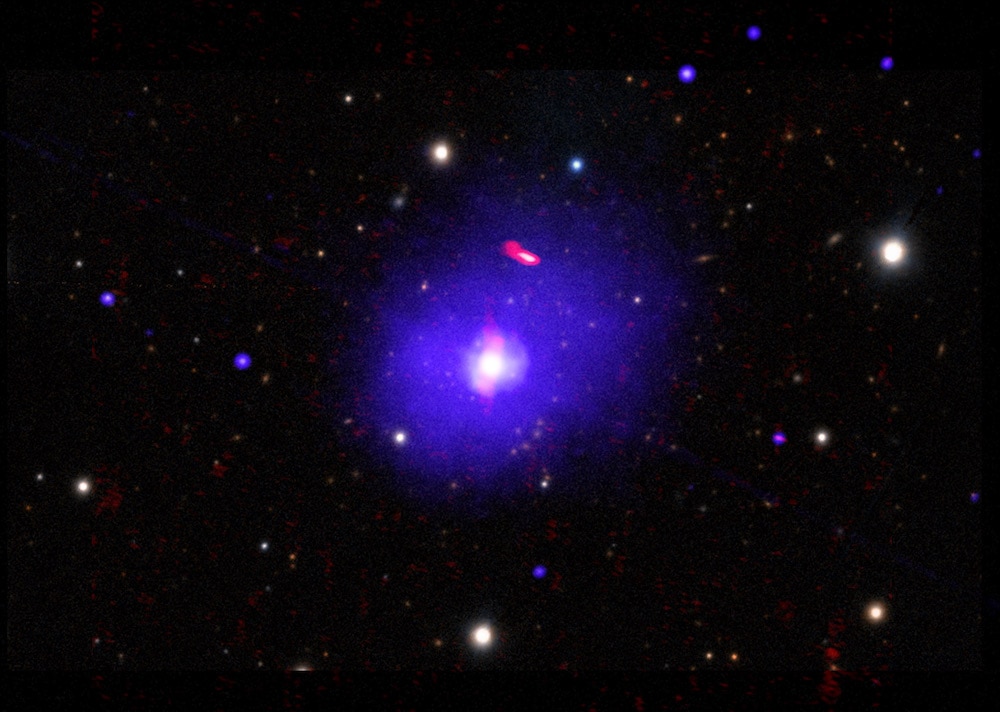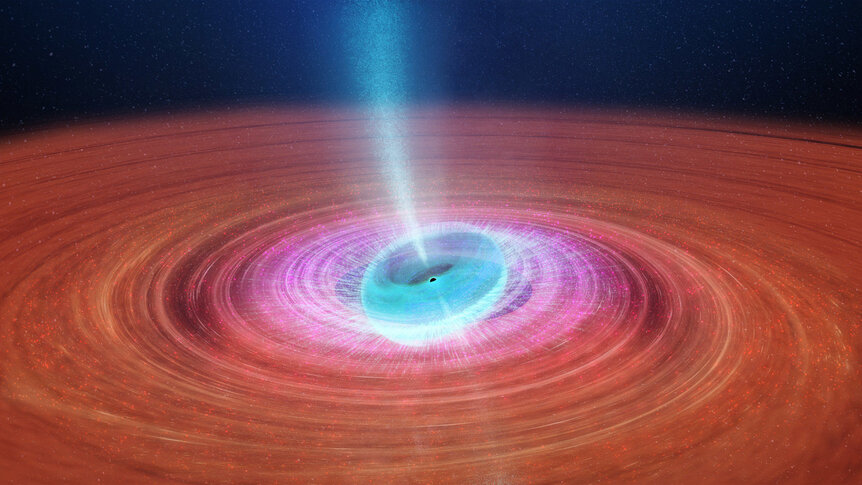Create a free profile to get unlimited access to exclusive videos, sweepstakes, and more!
Monster black hole spinning at only — 'only' — 60% the speed of light
Spin rate of supermassive black hole found to be less than that of lower mass ones.

If you want to know everything about a black hole, you only need to know three things about it.
One is its mass. That’s the big one; it controls the size of the black hole’s event horizon — the Point of No Return — as well as the strength of its gravity.
The second is its electrical charge, though this is more of a technicality: They can have a charge, but in general they eat as many positive as negative subatomic particles when gas and dust and stars flow in, so overall they’re usually electrically neutral.
The third is its spin, which is a hard concept to understand. Black holes form as material collapses down into a very small volume of space, so much so that the density shoots up and the gravity follows suit. But material almost never falls straight in; it always has some sideways velocity, like water spinning around a drain. As the material flows in that spin increases — we call this conservation of angular momentum, and it's the same reason an ice skater’s spin increases as they bring their arms in.
Angular momentum can’t just disappear, so even when this object becomes a black hole that spin is still there. And as weird as that is, it gets a lot weirder: The black hole drags the fabric of spacetime around it like a ball spinning in honey, and we can see that effect in material as it orbits around the black hole.
Measuring the spin of a black hole tells us a lot about how it might have formed and the environment it was in when that happened, so it’s a big goal of astronomers to determine it.
Observations have been made of a ginormous black hole in the center of a galaxy called H1821+643, which is about 3.4 billion light-years from Earth. This galaxy is called a quasar, because the black hole is actively feeding on material, which gets so hot as it falls in it gets incredibly bright. And I do mean bright: That material is so luminous it’s blasting out about one hundred trillion times as much energy as the Sun. That’s thousands of times brighter than our entire Milky Way galaxy!
The black hole in the center of H1821+643 is huge, though its mass isn’t well constrained by observations; it may be anywhere from 2 to 30 billion times the mass of the Sun, so no matter what it’s a kaiju among monsters. It’s surrounded by an enormous accretion disk of material whirling around it, so hot it emits X-rays, which is how astronomers were able to figure out the black hole’s spin [link to paper].
In a typical orbit, like a planet around a star, the speed of the planet’s orbital motion depends on the mass of the star and how far it is from it. That’s true in a black hole as well, but there’s an added twist: The black hole’s frame dragging, how hard it’s wrapping spacetime around itself as it spins. This allows material to orbit closer to the black hole before falling in, and that’s the key to determining its spin rate.
Hot gas around the black hole emits X-rays, and these can be reflected by the material on the inner edge of the accretion disk, the stuff closest to the black hole. The reflected X-rays are Doppler shifted by the moving material, and the amount of that shift depends on how rapidly — and therefore how close — that material is to the black hole.
So a team of astronomers used the Chandra X-ray observatory to look at the amount of Doppler shift there was in the X-rays reflected by the inner material swirling around the black hole in H1821+643, and used it to determine the amount of frame dragging and therefore the black hole’s spin.
What they found is rather surprising. Most black holes are spinning at extremely rapid rates, very near the speed of light. But this one is slower, only about 60% lightspeed, and that’s very interesting indeed.
Tangent: Imagine a basketball player balancing a ball on their fingertip and spinning it. They use their other hand to skim the ball’s surface, accelerating the rotation to keep it balanced. They always move their hand in the same direction to increase that speed. If they instead skimmed it in the other direction the ball would slow down, right?
A similar thing happens in black holes. Material (stars, gas, dust) in a rotating galaxy tends to fall in to the central black hole from the same direction (say, clockwise), which increases the black hole’s spin. Over billions of years we see black holes like this with spins near that of the speed of light.
But if the material falling in comes from every which-way, it might add to the black hole’s spin or it might subtract from it, slowing the spin rate. A black hole forming from material infalling to make a galaxy might have a rapid spin, but one that grows by eating other galaxies that fall in from random directions might have a much slower spin.
Measuring the spin of a black hole hints at how it formed.
H1821+643 is a big galaxy, and as other galaxies collided with it over time it ate and merged with them; they fell to its center, and their own supermassive black hole merged with the one already there. This can easily slow the spin of the bigger black hole, dropping it from near lightspeed to a mere 60%.
The biggest black holes form this way, so it’s predicted that most will have slower spins than smaller black holes that rotate at near maximum speed. These X-ray observations of H1821+643 support that conclusion.
Incredible. Black holes tend to eat everything around them and erase the evidence of what they’ve done, turning everything that falls in into simply more black hole. But like a sloppy criminal they can’t erase all the evidence, and from what’s left we can deduce the events of the crime.
This is difficult to do, certainly, and we’re still in the early stages of examining nearby massive black holes. But this new work shows, indubitably, that the game is afoot.




























